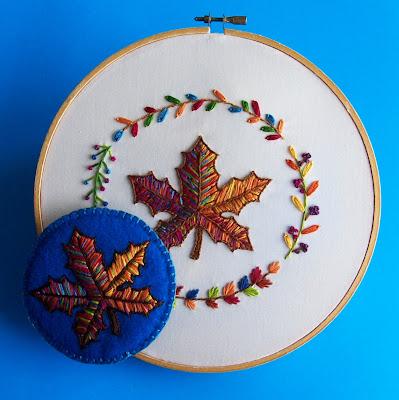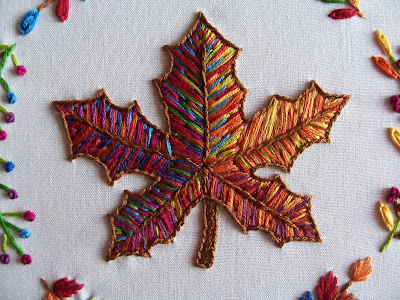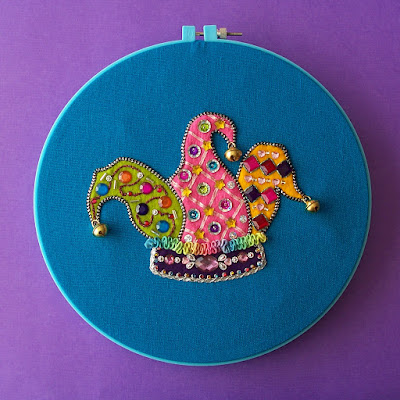Please click on any photo to view it larger
The Joyful Jester
Felt on Linen with Embellishments
I have an exciting project to share today! At the end of June, I discovered that
The San Francisco School of Needlework & Design (SFSNAD) was hosting a
Stitch At Home Challenge, free to anyone who wanted to enter and open Internationally! If you missed this challenge, worry not, for they will be offering more in the future 😊
Each challenge has a theme, and the theme for this round was
Burlesque. Admittedly, at first, I wasn't all that interested as Burlesque brings to mind dancing girls with feather fans at best. However, when I looked through the
Inspiration blog, I realized that the SFSNAD interpretation was much broader. As the blog says, in part:
"This Stitch-at-Home Challenge is intended to pull out the whimsical, the subversive, and the exaggerated parts of ourselves and our world. Throughout time, people have been responding to experiences that bump up against their sensibilities, that provoke a feeling of ridiculousness, frustration, or celebration. How do we reframe, exaggerate, or explode these feelings? Where do we find outrageous joy?"
I don't know if it's outrageous or not, but personally I find a great joy in stitching, which far surpasses the simple act of pulling a threaded needle through fabric. It is relaxing, absorbing, fascinating and endlessly surprising, and I wanted to capture some of that happiness in my project 😄 I wanted something colourful and cheerful 🎨🌈!
This image of Harlequin statuettes from the blog caught my eye:
Curious, I did a bit of Googling, and I found these delightful Harlequin illustrations from the
Italian Commedia Dell'Arte, which according to the
Metropolitan Museum, was "
a theatrical form characterized by improvised dialogue and a cast of colorful stock characters that emerged in northern Italy in the fifteenth century and rapidly gained popularity throughout Europe." I loved the exuberant feathered costumes!
And those lead me to modern
Venice Carnivale masks, which are bright and colourful:
Naturally, I wanted to make a wearable mask of my own! Something extravagant, with peacock feathers and lots of glittery bits. But as it is too early here for Hallowe'en I couldn't find a basic domino mask to use as a base and I didn't think felt would be stiff enough. I have always loved the figure of a Jester, and the idea of a merry joker, and so I decided to echo the outlandish cheer of the Harlequin costumes in my Jester's Cap.
Every challenge participant received a
Kreinik Bag O' Bits to use in their stitching, courtesy of Kreinik, and I was so excited to finally be able to try out their metallic braids! I have been fortunate enough to inherit some stash of their Blending Filaments from my Stitchy Guru Mother, and while I love the shine of those, they are very fragile and need to be combined with a "carrier thread", normally some strands of DMC floss.
My bag had a good mix of colours. Most were short strands and not useable for any amount of stitching but there was a wonderful variety of textures and it was a great introduction to the wide range of products Kreinik manufacturers. It has definitely piqued my interest! There were three short two-inch lengths of the prettiest silver holographic flat ribbon that shone so brightly, and I'm going to search for that thread!
I had a lot of Big Ideas, but in the end I found a simple outline pattern I liked, a heraldic Jester's Cap from the
Mistholme Pictorial Dictionary of Heraldy (which is well worth a browse if you're interested in old crests and the way they were designed):
And then I just went to town! I pulled out my collection of felt, and my Magical Tin of Embellishments. What's really interesting is that as long as I can remember, my Stitchy Guru Mother has keep a wonderful box of trimmings which comes out only for really special projects - Hallowe'en costumes, Christmas ornaments, dresses for special events - and has all kinds of pretty trims, crystals, rhinestones and sequins. I was thrilled to discover that I've FINALLY accumulated enough pretties to have one of my own, a hexagonal Quality Street chocolate tin full to the brim with sparkle and glitter ❤💎✨
There was no real rhyme or reason to the design, it was truly Spontaneous Stitching! I printed off the line drawing and cut it into four pattern pieces - three horns and the band. Then I cut those pieces out of felt (green, pink, yellow and purple). Then I spent an incredibly happy sunlit afternoon absorbed in playing with sparklies, spreading my supplies out on my Grandma's kitchen table and playing with the crystals until I got a design I liked. I glued the acrylic rhinestones on with
Aleene's Fabric Fusion Glue.
Here's a Before-and-After shot, which shows the difference the trim makes! The pieced pattern is on the left, embellished with glued-on rhinestones, Kreinik threads, sequins and sead beads, and the fully embellished Cap is on the right, with the black-and-silver braid, silver picot trim, ruched ribbon band and jingle bells added:
Everything except the rhinestones was hand-stitched on, using Invisible Thread (
Coats Transparent). This is very fine, and is excellent for adding seed beads!
I knew I wanted to echo the diamonds of the traditional Harlequin costume, so on the right side I glued square rhinestones at an angle to create diamonds of pink, red and purple. I outlined these in a turquoise Kreinik braid (I think it's a
#8 braid) and added large silver e-beads. The center section has a Trellis of Couched iridescent Kreinik ribbon with layered sequin filling and the left horn has rhinestone "Polka Dots", with scattered silver bugle beads and Stem Stitched Kreinik braid, in a pink/purple mix.
The trims I added took the most time to sew on, but they added a lot of impact:
The local quilt store was once a craft store and they have a very small stock of odds and ends. That is where I found this fabulous silver-and-black braid, which is actually meant for Plastic Canvas. I outlined all three of the horns of the hat in this thread, Couching it to follow the shape of the pattern. I love it, and to me it feels Harlequin-like 😊
The background fabric, the pretty peacock blue, is a linen I found there too!
The other four trims are silver braids made by Tahl. After some auditioning, I went with the one at the top left, a pretty picot braid with diamond-patterned edges. I Couched this around the bottom of the hat band, and then I filled each little picot with a silver-lined sparkly seed bead in an alternating pattern of turquoise, yellow and red. Although it's a very small detail, the beads catch the light wonderfully in real life!
Here's my attempt to capture the sparkle, in the sunshine:
My favourite part is probably the rainbow Ruched Ribbon at the top of the band:
It took me several tries and many stabbed fingers, but eventually I - more or less - got the trick of ruching the ribbon, which is multi-coloured double-sided satin by Offrey. I used a simple zig-zag design shown in the tutorial for a flower on
Nikki, In Stitches.
To make sure my stitches didn't show, I used Invisible Thread, which made the process slow going. The stitches vanished against the variegated colours when the ruching was complete BUT I couldn't clearly see the stitches as I was making them, which made it difficult to keep them even. I ended up marking dots along the sides for spacing with a purple
Disappearing Marker. I would suggest practicing on a plain colour ribbon with matching sewing thread first! It is a great technique I'd like to try again.
The three jingle bells are ones I've saved from the collars of the
Lindt Easter Bunnies! They are so pretty, and I always hoped to find a use for them. They sound very nice when rung too 😁 The Bunnies have become a family tradition in recent years. The bells would look lovely on Christmas ornaments too - any excuse to buy more chocolate 🍫
When I was a little kid, my Stitchy Guru Mother created a marvelous distraction device called The Glue Box. It was a plastic container filled to the brim with construction paper, crayons, markers, stickers, glitter glue, pipe-cleaners, pom-poms, popsicle sticks, beads and other cool crafty stuff. Many were the hours I passed in a creative blur, making one genius - to my mind, I'm sure - artwork after another to proudly be given to relatives as gifts or displayed on the fridge until the next "masterpiece" was concocted.
There was spontaneity in it, and joy. Truly outrageous, overwhelming, all-encompassing joy! As an adult, I don't often give myself free reign to just jump in and experiment with something, and I'm sure I'm not the only one. This was a challenge for me in many ways, but most importantly to my confidence. Especially early on, I nearly gave up on my Jester's Cap for good several times - I thought it was too juvenile, too hokey, too kitschy, too amateurish. How, I wondered, could I possibly submit this to the SFSNAD?
But as I persevered, something amazing happened! I remembered The Glue Box and the happiness of making something just for the sake of making something. To my surprise, I found a measure of real joy, and in these difficult days of loss and family illness, it is all the rarer. It's a true treasure to find, and I am extremely grateful. In the future, I hope to do some more Spontaneous Stitching, and I highly recommend trying it!
Thanks very much to
The San Francisco School of Needlework & Design (SFSNAD) and
Kreinik for hosting the
Stitch At Home Challenge and for opening it up to International stitchers like myself! I really enjoyed trying new techniques (the felt applique and ribbon ruching), new materials (Kreinik metallic threads) and expanding my stitchy horizons!
Helpful Articles About Kreinik Metallic Threads:
💠 From the Kreinik blog:
How to Read a Kreinik Thread Label
💠 Nordic Needle's
Stitching Guide on Kreinik Metallics has a brief overview of the history of metallic threads and the Kreinik Company, as well as stitched samples;
💠
Peacock & Fig has a
wonderful article that demonstrates the difference between the Blending Filament and the Braids in great stitched samples;
💠 The Cross Stitch Review Blog has very detailed overview of the
Blending Filament;
💠 Ancora Crafts has an in-depth
Glow In The Dark Thread comparison, in which most of the contenders are Kreinik, as does the
Freudian Stitch blog.
Have you ever tried indulging your whims and Spontaneously Stitching? Would you?!




























































